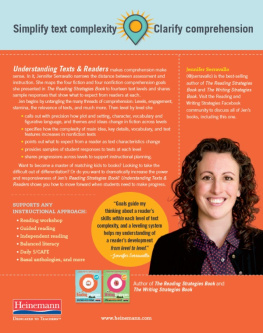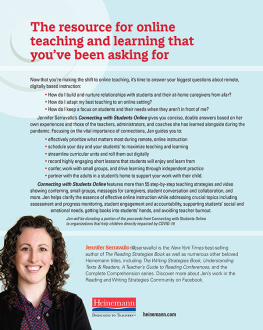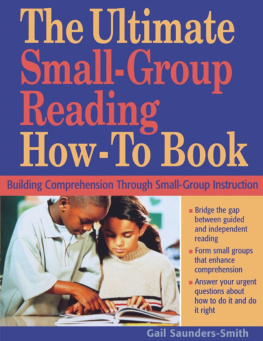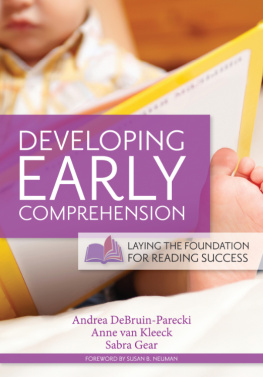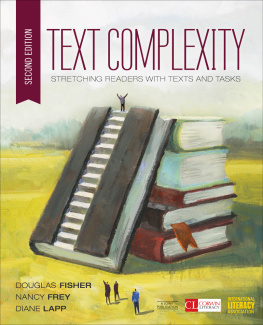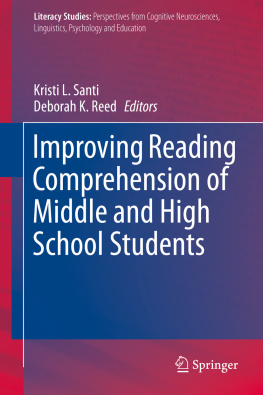Heinemann
361 Hanover Street
Portsmouth, NH 038013912
www.heinemann.com
Offices and agents throughout the world
2018 by Jennifer Serravallo
All rights reserved. No part of this book may be reproduced in any form or by any electronic or mechanical means, including information storage and retrieval systems, without permission in writing from the publisher, except by a reviewer, who may quote brief passages in a review, and with the exception of reproducible pages (identified by the Understanding Texts & Readers copyright line), which may be photocopied for classroom use.
Dedicated to Teachers is a trademark of Greenwood Publishing Group, Inc.
The author has dedicated a great deal of time and effort to writing the content of this book, and her written expression is protected by copyright law. We respectfully ask that you do not adapt, reuse, or copy anything on third-party (whether for-profit or not-for-profit) lesson-sharing websites.
As always, were happy to answer any questions you may have.
HEINEMANN PUBLISHERS
A Note About Text Levels Assigned to Childrens Books
This book includes discussion of a variety of quantitative and qualitative text leveling systems (i.e., DRA, F&P Text Level Gradient, Reading Recovery, Lexile, and more). For the purposes of consistency, all childrens books I write about in Understanding Texts & Readers were leveled through www.fountasandpinnellleveledbooks.com. Their leveling system is used by others across other leveling sites and apps, but the website is the only official source. Some books mentioned in Understanding Texts & Readers did not appear in the database at all, and in those cases I approximated the levels based on the text characteristics identified by Fountas and Pinnell in their many publications, including The Literacy Continuum. If you use another leveling source, or rely on a different leveling system without an official source, you may find discrepancies across different sites and apps.
As you read the book, youll learn that leveling is not a perfect science. The level assigned to a specific book can sometimes change based on new thinking by experts. Its crucial to build your knowledge about texts and become comfortable forming your own judgments about the books you offer your readers. I hope Understanding Texts & Readers helps you do just that.
The author and publisher wish to thank those who have generously given permission to reprint borrowed material:
Hierarchy of Reading Goals from The Reading Strategies Book by Jennifer Serravallo. Copyright 2015 by Jennifer Serravallo. Published by Heinemann, Portsmouth, NH. All rights reserved.
Lexile levels for side-by-side text comparisons from www.lexile.com. Copyright Metametrics Inc. Used with permission from MetaMetrics Inc. Lexile is a trademark of MetaMetrics Inc. and is registered in the United States and abroad. All rights reserved.
Excerpts from The Moon Book by Gail Gibbons. Copyright 1997 by Gail Gibbons. Published by Holiday House Publishing, Inc. Used by permission of the publisher.
Readers Reflect on Our Reading Lives by... chart from The Reading Strategies Book by Jennifer Serravallo. Copyright 2015 by Jennifer Serravallo. Published by Heinemann, Portsmouth, NH. All rights reserved.
Sara Ahmeds identity web from Upstanders by Harvey Smokey Daniels and Sara K. Ahmed. Copyright 2015 by Harvey Daniels and Sara K. Ahmed. Published by Heinemann, Portsmouth, NH. All rights reserved.
Heart map from The Writing Strategies Book by Jennifer Serravallo. Copyright 2017 by Jennifer Serravallo. Published by Heinemann, Portsmouth, NH. All rights reserved.
Reading Interest Survey from But Theres Nothing Good to Read (In the Library Media Center) by Denice Hildebrandt, originally appearing in Media Spectrum: The Journal for Library Media Specialists in Michigan (vol. 28, no. 3, pp. 3437, Fall 2001). Used by permission of the author.
The Diversity Gap in Childrens Books Infographic, published by Lee & Low Books, featuring data from the Cooperative Center for Childrens Literature. Used with permission from Lee & Low Books, Inc.
Sample Character Traits list from www.readwritethink.org. Copyright 2013 IRA/NCTE. Used with permission from National Council of Teachers of English. All rights reserved.
Talk map from The Reading Strategies Book by Jennifer Serravallo. Copyright 2015 by Jennifer Serravallo. Published by Heinemann, Portsmouth, NH. All rights reserved.
Image Credit
page 182: photo Hero Images/Getty Images
Cataloging-in-Publication Data is on file at the Library of Congress.
ISBN: 978-0-325-10892-6
Editor: Zo Ryder White
Production: Victoria Merecki
Cover and text designs: Suzanne Heiser
Front cover art: Maxchered / Getty Images
Photography: Nicholas Christoff and Michelle Baker
Typesetter: Gina Poirier, Gina Poirier Design
Manufacturing: Steve Bernier
e-ISBN: 978-0-325-10938-1
How Understanding Texts & Readers Can Help
My preferred framework for reading instruction is balanced literacy, with a strong reading workshop at its core. In classrooms like these, teachers offer opportunities for students to practice reading independently every day; some time for kids to work collaboratively and in conversation with partnerships and book clubs; instruction around skills identified in standards through whole-class minilessons, shared reading lessons, and interactive read-alouds; small-group and one-on-one lessons with students based on individual goals; and instruction using a strong word study/phonics program. Youll read about this approach throughout this book.
That said, if you or the school you work in uses a different approach to reading instruction, you will find that this book offers you support for learning about childrens books and the students under your care with more depth and precision. This knowledge will help you as you assess and teach readers to support their comprehension.
In the two tables that follow, I discuss how this book can help you with various reading instruction challenges regardless of your approach to literacy instruction.
CHALLENGE | HOW UNDERSTANDING TEXTS & READERS CAN HELP YOU |
Leveled texts are misunderstood. | This book helps position levels where they belong: as a teachers tool, not as a label for kids. (Fountas and Pinnell 2006, 2016, 2017a; Parrott 2017). This book will show you how to use them as a tool to help with assessment, identifying goals for readers, and figuring out which strategies to teach. |
It can be hard to confer with readers when you havent read the book the student is reading. | This book shows you how to use text characteristics and expectations for reader response to inform your instruction. |
If you use guided reading, for it to be most effective, it needs to be about teaching the reader, not just the book. | By focusing on characteristics of texts, youll learn what to focus on during guided reading lessons, what strategies will work best for that level of text, and what to expect of reader response. |
Comprehension can feel nebulous. Its one thing to identify that kids arent getting it but harder for you to put your finger on what skills, exactly, you should teach. | This book relies on the same goals as |

